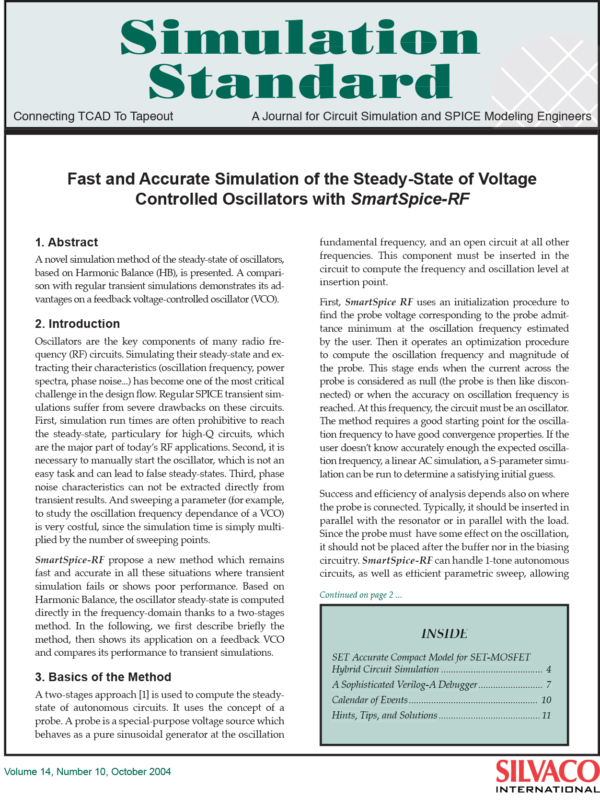Fast and Accurate Simulation of the Steady-State of Voltage Controlled Oscillators with SmartSpice-RF
1. Abstract
A novel simulation method of the steady-state of oscillators, based on Harmonic Balance (HB), is presented. A comparison with regular transient simulations demonstrates its advantages on a feedback voltage-controlled oscillator (VCO).
2. Introduction
Oscillators are the key components of many radio frequency (RF) circuits. Simulating their steady-state and extracting their characteristics (oscillation frequency, power spectra, phase noise…) has become one of the most critical challenge in the design flow. Regular SPICE transient simulations suffer from severe drawbacks on these circuits. First, simulation run times are often prohibitive to reach the steady-state, particulary for high-Q circuits, which are the major part of today’s RF applications. Second, it is necessary to manually start the oscillator, which is not an easy task and can lead to false steady-states. Third, phase noise characteristics can not be extracted directly from transient results. And sweeping a parameter (for example, to study the oscillation frequency dependance of a VCO) is very costful, since the simulation time is simply multiplied by the number of sweeping points.
SmartSpice-RF propose a new method which remains fast and accurate in all these situations where transient simulation fails or shows poor performance. Based on Harmonic Balance, the oscillator steady-state is computed directly in the frequency-domain thanks to a two-stages method. In the following, we first describe briefly the method, then shows its application on a feedback VCO and compares its performance to transient simulations.
3. Basics of the Method
A two-stages approach [1] is used to compute the steady-state of autonomous circuits. It uses the concept of a probe. A probe is a special-purpose voltage source which behaves as a pure sinusoidal generator at the oscillation fundamental frequency, and an open circuit at all other frequencies. This component must be inserted in the circuit to compute the frequency and oscillation level at insertion point.
First, SmartSpice-RF uses an initialization procedure to find the probe voltage corresponding to the probe admittance minimum at the oscillation frequency estimated by the user. Then it operates an optimization procedure to compute the oscillation frequency and magnitude of the probe. This stage ends when the current across the probe is considered as null (the probe is then like disconnected) or when the accuracy on oscillation frequency is reached. At this frequency, the circuit must be an oscillator. The method requires a good starting point for the oscillation frequency to have good convergence properties. If the user doesn’t know accurately enough the expected oscillation frequency, a linear AC simulation, a S-parameter simulation can be run to determine a satisfying initial guess.
Success and efficiency of analysis depends also on where the probe is connected. Typically, it should be inserted in parallel with the resonator or in parallel with the load. Since the probe must have some effect on the oscillation, it should not be placed after the buffer nor in the biasing circuitry. SmartSpice-RF can handle 1-tone autonomous circuits, as well as efficient parametric sweep, allowing applications like VCO frequency tuning. Additionnally, a small-signal noise analysis can be performed around the steady-state operating point to compute phase noise (as well as total output noise). Phase noise is usually characterized in terms of the single-sideband noise spectral density. The phase noise is defined as mean-square noise voltage density to the mean-square carrier voltage, and reports the ratio in decibels [2]:



